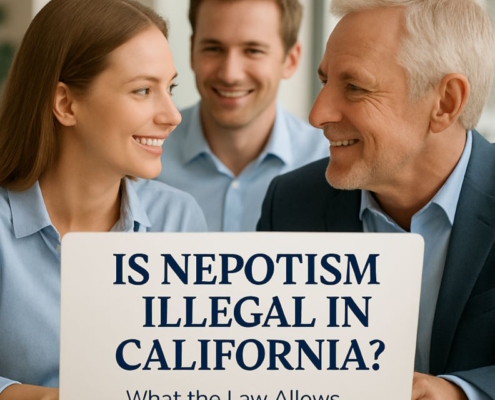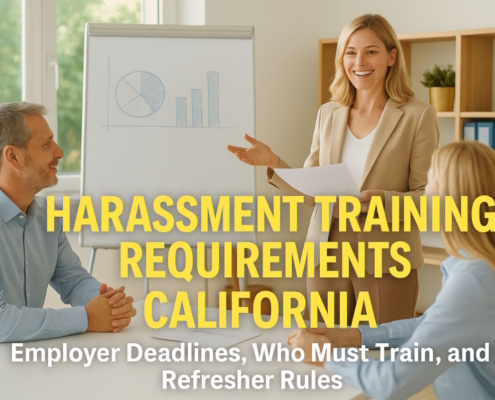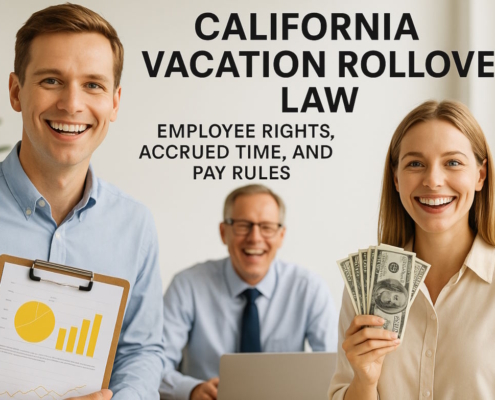Is it a legal requirement to have an employee handbook?
Employers are not legally required to provide workers with an employee handbook. However, federal and state laws require companies to provide employees with information about workplace rights, sick leave policies, paid time off (PTO), etc.
By Douglas Wade, Attorney
Email | Call (800) 484-4610
When should you have an employee handbook?
In general, when a new employee joins a company, they receive an employee handbook during the onboarding process. This handbook reviews the company’s rules, policies, expectations, and procedures. While the state of California does not make having an employee handbook a legal requirement, there are benefits to writing and providing one. What an employer chooses to include in their handbook will depend on their business’ needs and the particular industry they are part of. By law, some policies must be communicated to employees, and the employee handbook is a convenient place to present this information.
That is to say, there is a legal requirement to have a written statements of conditions and terms, otherwise referred to as an employment contract. This contract conveys the essential employment information that an employee must agree to in order to be successfully onboarded. But a handbook, containing additional information about employee benefits, company culture, and specific company requirements, is not legally required. In this article, our employment lawyer attorney for companies discusses reasons for employers to have an employee handbook as follows:
How much does it cost for an employee handbook?
At Nakase Wade, we have a low fee for writing a company handbook, starting at $2,500 for employers with less than 30 California employees; $5,000 for employers with greater than 31 California employees.
What are the advantages of having an employee handbook?
An employee handbook provides employees with objectives, management styles, and HR best practices to foster beneficial management-employee relationships. One of the major benefits of creating an employee handbook is reducing a business’ risk of being sued. For instance, by putting a dignity at work or an equal opportunities policy in the handbook, an employer gives themselves a defense if an employee sues them over harassment or discrimination. At a legal tribunal, the employer may show that they took legitimate steps to discourage or prevent the bad behavior. That said, this benefit is only applicable if the policy is consistently enforced.
Another advantage of having an employee handbook is that it offers consistency. Employees will understand what their expectations are and what benefits they are entitled to. Managers and supervisors will understand procedures, and there will be no room for misinterpretation or misunderstanding. An employee handbook also provides a place for an employer to expand on their values and desired company culture.
What should an employee handbook include?
An employee handbook should include the company’s policies and expectations. The following should be included in a company handbook:
- General employment information Process for filing a complaint
- At-will nature of employment
- Code of conduct
- Meal and rest periods
- Overtime eligibility
- Timekeeping
- Paydays
- Pay policies
- Evaluation process for promotions and raises
- Paid vacation policy
- Sick leave policy
- Safety and security
- Anti-retaliation
- Anti-harassment
- Equal employment opportunity (antidiscrimination)
A handbook may also include a punitive policy and a grievance policy, so that employees know what their expectations are and where and how they may file a complaint about the workplace. The handbook is also the appropriate place to describe the workplace retirement scheme – again, even if this information has already been included in the employees’ contract.
If a business has more than five employees, then it must have its safety and health policy in writing, as well.
Only a few select employers require whistleblowing policies, such as those that work in financial services and those who are subject to regulation.
For an employer’s protection, it is also recommended to have an anti-discrimination policy and an antiharassment policy. These can help defend a lawyer in the event of a harassment or discrimination lawsuit.
How do you write a simple employee handbook?
When composing an employee handbook, an employer should start with an introduction that gives new employees a short overview of the business and the handbook itself. This statement should reflect the company’s values and culture.
The handbook should then go into specific policies, which should be grouped by topic, or by non-contractual and contractual status. For instance, an employer may group employee benefits together, and discrimination policies separately. However an employer wishes to structure their employee handbook, he or she should clarify which policy is contractual and which is non-contractual.
After an employer gives an employee their handbook, the employee should confirm receipt of the handbook and show that they have reviewed and consented to its contents. This is an especially important step if the handbook contains contractual policies. Agreement may be in the form of checking a box, sending a confirmation email, or signing a paper copy of the handbook.
An employer should also consider what form he or she wants the handbook to be in. One may decide to use an electronic PDF copy, a hard copy, or a copy that is accessible via the company’s intranet.
Can an employee handbook be changed?
It is important that an employer review their employee handbook on a regular basis. This is vital if there have been changes to the business. It is recommended that an employer update their handbook once every year at minimum. If an employer makes reference to any statutory rates in their policies, such as pay for sick days, then these should be reviewed and updated in October and April.
When updates are made to the handbook, employees and staff should be granted access to the most recent version for their reference. When an employer amends contractual policies, he or she will need to have their employees agree to the changes. This is an important step because an employer does not want to risk an unfair dismissal or breach of contract claim. Non-contractual policies, however, may be amended without consulting employees or staff.
Have a quick question? We answered nearly 2000 FAQs.
See all blogs: Business | Corporate | Employment
Most recent blogs:
































